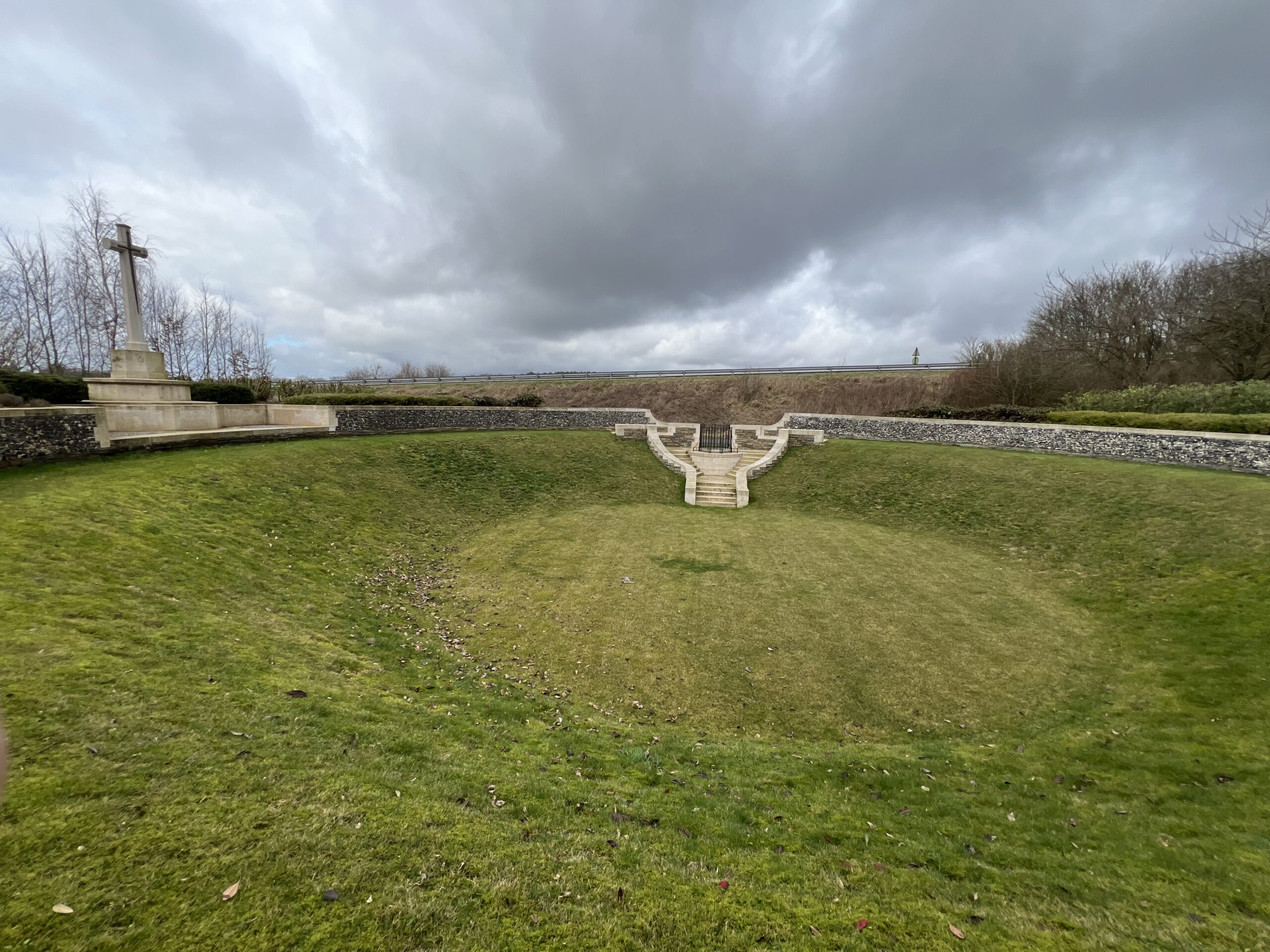There are two very interesting Canadian Cemeteries near Neuville-Saint-Vaast, were the burial of Canadian soldiers found on the Vimy battlefield were laid to rest in two mine craters. They are essentially two mass graves.

Zivy Crater sits just below Vimy Ridge and was the jump off point for the Canadian assault on the 9th April 1917. The crater had been created on the 3rd April 1916, when the Germans detonated explosives laid under the British lines by German tunnellers. It killed one man and injured four more of the 6th Battalion, the Black Watch. The crater was occupied by British Troops thereafter.

On the 9th April 1917 18th Battalion (Western Ontario) advanced from Zivy to attack the German lines near Thelus in their successful attempt to capture Vimy Ridge. When they returned, they brought some of their fallen comrades and buried them in the crater.

It contains fifty-three First World war burials, five of them unidentified. The names of the men buried in the crater, all of whom died in April and May 1917 are inscribed on panels fixed to the boundary wall.

Lichfield Crater was also formed from German mining and created in 1916. It is very close to Zivy Crater but now separated by a motorway. Again, it was used as a launching point for the Canadian assault on Vimy Ridge and then utilised as a burial ground for the fallen soldiers after the battle. The crater is again a mass grave and contains fifty-seven burials, 15 of them unidentified. All the men buried here died on either the 9th or 10th April 1917. After the Armistice a grave was found on the edge of the crater, who had died in April 1916. His grave is the only one marked with a headstone. The names of the fallen Canadian are inscribed on panels fixed to the wall.



Of those soldiers laid to rest at Lichfield Crater was Lance Serjeant Ellis Welwood Sifton VC His Victoria Cross citation which was published on the 8th June 1917 read as follows: ” For most conspicuous bravery and devotion to duty. During the attack in enemy trenches Sjt. Sifton’s company was held up by machine gun fire which inflicted many casualties. Having located the gun he charged it single-handed, killing all the crew. A small enemy party advanced down the trench, but he succeeded keeping these off till our men had gained the position. In carrying out this gallant act he was killed, but his conspicuous valour undoubtedly saved many lives and contributed largely to the success of the operation.”


The cemetery was designed by WH Cowlishaw.
I then visited the Cemeteries of La Targette in Neuville-St. Vaast. The British Cemetery was formerly known as the Aux-Rietz Cemetery and has a high proportion of Artillery Men buried there. There is the Memorial to the Royal Field Artillery nearby.

Next door is the French Cemetery. On 9 May 1915, the French army launched a major offensive against the German positions on the Artois hills. The capture of Neuville was a major objective before regaining a foothold on Vimy Ridge. On the German side, the village was protected by four lines of defence and each of its 150 houses was transformed into a fortress bristling with cannons and machine guns.
On the outskirts of the village, the famous “Labyrinth”, with its kilometres of trenches flanked by forts and blockhouses, is considered an impregnable position. The French conquered it piece by piece, at the end of a fierce struggle that lasted until 17 June 1915 and cost the lives of thousands of men, many of whom are now buried in the necropolis of La Targette. Neuville Saint-Vaast in their hands was nothing more than a heap of ruins.

This was the second battle of Artois, and the objective was to capture the Vimy Ridge. There were three battles of Artois in 1915 and the losses were huge. The La Targette French cemetery is the resting place for just over 11,000 French soldiers. 3,282 unidentified soldiers are placed in an Ossuary. Overall, the French suffered 102,000 casualties in the battle. An additional 40,000 French soldiers were buried at the Cemetery of Notre Dame de Lorette.

These French Cemeteries are visually massive, with their simple crosses and straight lines.

About half a mile down the road is the Neuville St Vaast German Cemetery which contains over 44,000 German burials.
Neuville St Vaast is certainly the home to the fallen.


Absolutely splendid. It was as if we were travelling with you. Superb description. Well balanced. Keep up the good work.
Thank you Mr Petty. You are my inspiration.
Wonderful pictures! What’s the middle cemetery in the three pictures of French cemeteries? What a great capture of perspective.
Susan, many thanks for the reply. I used a small panorama shot of the same cemetery to get this effect. The pictures are all from the same cemetery. It is vast and its size makes you think of the waste of life there.